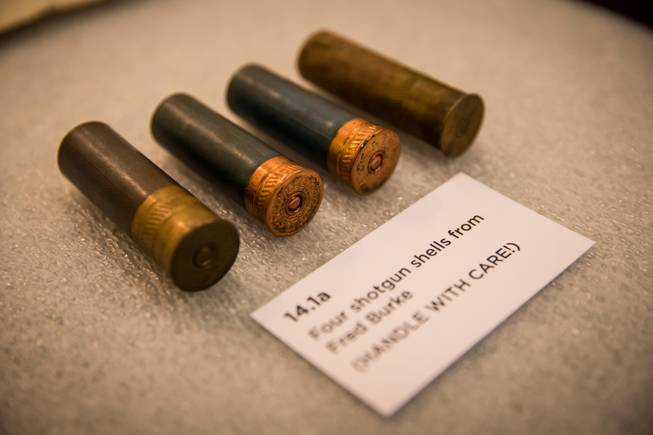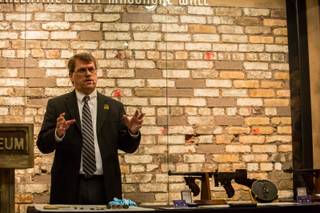
Various artifacts have been added to the St. Valentine’s Day Massacre exhibit at the Mob Museum, Friday, Feb. 10, 2017. The artifacts are associated with the notorious 1929 gang slayings in Chicago.
Saturday, Feb. 11, 2017 | 2 a.m.
The Mob Museum started its fifth anniversary celebration with an appropriate bang, unveiling new artifacts from the St. Valentine’s Day Massacre, including bullets removed from the bodies of the victims and the original coroner’s documents. They connect to one of the most significant pieces in the permanent collection: the brick wall against which seven associates of notorious Chicago mobster Bugs Moran were gunned down in 1929.
Opening day in 2012 — Valentine's Day — was chosen to reflect the importance of the artifact to mob history, which the museum has enshrined in ways that have garnered national attention and awards. However, it had its critics in the early days, mostly taking issue with the tax credit it received from the city of Las Vegas. But on Feb. 15, museum leadership will announce the final $1.5 million payment of the $6 million total during the city council meeting. On its anniversary the day before, locals will be treated to free admission as part of a five-day observance of the museum's milestone.
FIVE YEARS OF THE MOB MUSEUM
Economic impact on downtown Las Vegas: $20.5 million annually
Visitors: 1.3 million
Countries represented by visitors: 36
States represented by visitors: 50
Museum members: 1,500
Volunteers: More than 90
Employees: More than 75
Audio tours taken: 26,000
Weddings held: 57
New artifacts acquired since opening: More than 2,000
Awards received: More than 50
“We do a pretty great job telling this connected story from the turn of the 20th century to the present day that’s about this ongoing struggle between organized crime and law enforcement, and the different innovations that occurred along the way for law enforcement to help solve crimes and prosecute criminals,” said executive director and CEO Jonathan Ullman.
Ullman and senior director of content Geoff Schumacher unveiled bullet fragments and cartridge casings retrieved from the garage floor, as well as test bullets fired from the Tommy guns used in the grisly execution. Lt. Mike Kline, from the sheriff’s department in Berrien County, Mich., displayed the two Thompson machine guns fired that day, and he will discuss their role in the crime on Tuesday.
Forensic ballistics was a new approach to solving crimes in the 1920s. The reports prepared by Calvin Goddard, a pioneer in the testing techniques, helped identify the weapons used in the infamous crime by matching the Tommy guns of Fred “Killer” Burke with the bullets found at the scene, Kline said.
But the Mob Museum is not just telling stories from generations past — it has offered temporary exhibits focused on contemporary topics, from the FIFA scandal to outlaw motorcycle gangs to the recently extradited Mexican drug lord El Chapo.
“We are very interested in telling the organized crime story historically as well as in the modern day,” Schumacher said.
Ullman views the Mob Museum as an informal learning institution in the Las Vegas community. He points to constitutional law and American history as examples of core subjects complemented by the museum’s focus. Last fall, it launched an online interactive history on the Prohibition era and implemented its Investigating History educational outreach program, which sends museum representatives into Clark County schools. So far, 4,800 students have been immersed in the unique history lesson.
“We have the ability to provide them with a cultural experience that can be quite special,” Ullman said. “I can still recall some very early visits during my childhood that set me on a particular path. There is something about a museum experience that is really important to young people, and if they can’t come here, we need to go to them.”


Join the Discussion:
Check this out for a full explanation of our conversion to the LiveFyre commenting system and instructions on how to sign up for an account.
Full comments policy